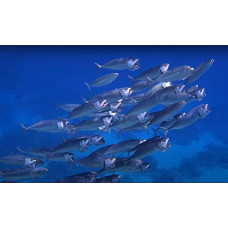Latin name
Rastrelliger kanagurta
Other names
Rastrelliger kanagurta
Identification
Body elongated, spindle-shaped, moderately high, covered with fine cycloid scales. Maximum body height on the vertical line just behind the edge of the gill cover is 4.0-4.8 times the standard body length. The head is longer than the body length. The snout is pointed. The anterior and posterior edges of the eyes are covered by a fatty eyelid. The teeth on the upper and lower jaws are small, conical in shape. There are no teeth on the scutellum and palate. The gill stamens are very long, visible when the mouth is open, and quite numerous (30-46 on the lower part of the first gill arch). The caudal peduncle is short and narrow. There are two small keels on the sides of the caudal peduncle, no central keel. A swim bladder is present. There are 31 vertebrae. The anal process is rudimentary.
Features of fish fins
The two dorsal fins are separated by a gap equal to or greater than the length of the base of the first dorsal fin. The first dorsal fin has 9-11 spiny rays. The second dorsal and anal fins each have 12 soft rays. Between the second dorsal and caudal fins and between the anal and caudal fins is a row of five smaller fins. The pectoral fins are short with 19-20 soft rays. The caudal fin is bifurcated.
Fish colouring
The back is bluish-green, the sides are silvery with a golden tinge, and the belly is grayish white. There are narrow dark vertical stripes along the upper half of the body (golden in freshly caught individuals). There is a black spot on the lower edge of the pectoral fins.
Distribution
Indo-West Pacific: from the Red Sea and East Africa to Indonesia, north to the Ryukyu Islands and China, south to Australia, Melanesia and Samoa. Entering the Eastern Mediterranean through the Suez Canal.
Habitat
Marine pelagic-neritic oceanodromic tropical species. Depth range 20-90 m.
Size
Maximum total length 42.1 cm, standard length up to 35 cm, usually 20-25 cm. Maximum age listed: 4 years.
Behavior
Adults are found in coastal bays, harbors, and deep lagoons, usually in murky waters rich in plankton. They form schools.
Food and feeding habits
They feed on phytoplankton (diatoms) and small zooplankton (crustaceans, ostracods, polychaete larvae, etc.). Small groups have been observed feeding on Cheilio inermis eggs immediately after spawning. Adults feed on microplankton such as shrimp larvae and fish.
Reproduction
Spawning is prolonged and restricted to coastal waters. In the Indian Ocean (near Madras), spawning lasts from July to January. To the south, in the area of Rameswaram Island (in the strait between India and Ceylon), the spawning period (based on observations of ovarian egg maturation in females) is from April to July. The developing eggs are about 1.2 mm (1.17 mm) in diameter, the yolk is unsegmented, and the fat droplet is large, measuring 0.34 mm in diameter. The hatching pre-larvae are 2.8 mm long. Larvae grow to 4 mm during the first day of life. Growth matures at a length of 40-52 cm. Eggs and larvae are pelagic.
Fishing
It is a targeted fishery. It is caught with drift nets, trolls and trawls.
Relationship with a person
Commonly sold fresh, frozen, canned, dried, salted and smoked.
| Classification | |
| Phylum | Chordata |
| Class | Actinopterygii |
| Squad | Scombriformes |
| Family | Scombridae |
| Genus | Rastrelliger |
| Species | R. kanagurta |
| Features | |
| Conservation status | Data Deficient |
| Habitat | Pelagic |
| Life span, years | 4 |
| Maximum body weight, kg | No information |
| Maximum length, cm | 42,1 |
| Sailing speed, m/s | No information |
| Threat to people | Edible |
| Way of eating | Planktonophage |
Indian mackerel
Tags: indian mackerel


